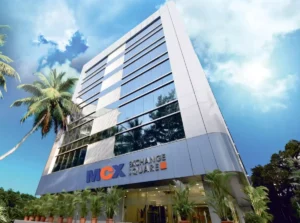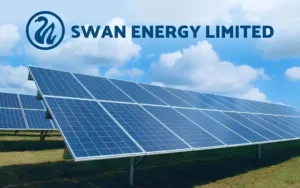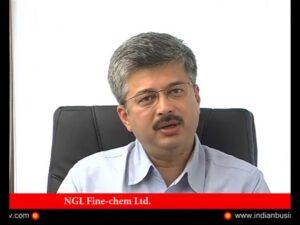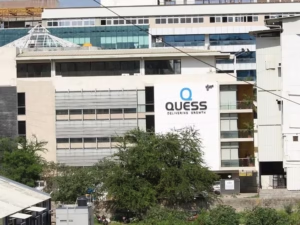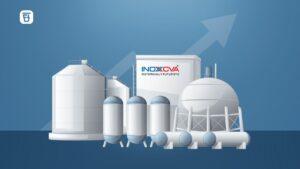At a Glance
Brookfield India REIT delivered a disappointing-probably‐expected ₹37 crore PAT in Q1 FY26, yet managed to reward unitholders with a ₹4.50 per‑unit distribution. Revenue climbed, debt is moderating thanks to recent capital raises, but RoE remains unimpressive. A classic case of income‑trust performance with just enough juice to keep investors mildly satisfied.
Introduction
Here we go again, Q1 FY26 of Brookfield India Real Estate Trust served up that familiar blend of “meh” earnings with slightly better leasing. PAT of ₹37.4 crore (compared to a loss last year) is technically a win, but with distributable cash flow flat at ₹216 crore (₹4.50/unit), the buzz feels more subdued than triumphant. The accommodative repo cut from April 2025 might offer some breathing room on interest expenses moving forward, but growth still relies heavily on acquisitions, neat leasing upgrades, and property monetization strategy. In short: income yield steady, equity growth sluggish, REIT drama continues. mint+12Moneycontrol+12Business Standard+12
Business Model (WTF Do They Even Do?)
Brookfield India REIT bundles high‑end office parks into a trust, monetizing rental income and handing it out quarterly as distributions. Think owning a handful of upscale campuses in Mumbai, Gurugram, Noida, Kolkata—charging rent, reducing debt, acquiring more real estate—and shoving cash to holders like a property vending machine. They recently bought a 50% stake in a 3.3 million sq ft portfolio from Bharti Enterprises, funded by issuing units at ₹300 to Bharti. Essentially, diluting equity to fund growth—and maybe hoping yield keeps them pacified. Business Standard+2Moneycontrol+2ICICI Direct+2
Financials Overview (200 words)
Revenue: ₹573.8 cr in Q1 FY26 vs ₹314.1 cr a year ago and ₹535.9 cr in Q4 FY25 – healthy growth of ~82% YoY and ~7% QoQ. PAT came in at ₹37.4 cr vs loss of ₹27 cr YoY, with distributable cash flow of ₹216.8 cr (₹4.50/unit) unchanged from the previous quarter. Gross leasing clocked ₹242,000 sq ft in the quarter. Moneycontrol+1Business Standard+1
EPS: ≈ ₹1.13 per unit, meaning annualized EPS ≈ ₹4.52. At closing price of ₹317‑₹318, annualized P/E ≈ 70‑71× (but business model = yield trust, not typical earnings multiple). mintICICI Direct
Interest coverage remains low due to heavy leverage—though recent QIP of ₹3,500 cr reduced debt. Guidance: NOI growth ~14% and distribution growth ~21% in FY26 per investor deck. Moneycontrol+7Brookfield India REIT+7The Economic Times+7
Performance highlight: revenue and PAT improving, but high P/E ratio (100+ per some estimates, others calculating GP/E) and persistent modest ROE (~1.3%) show investors aren’t getting equity-like returns. Distribution yield ~6%, consistent with prior quarters. Book value per unit ~₹336 as of March 2025. ICICI DirectThe Economic TimesBrookfield India REIT
Valuation
Let’s play REIT‑valuation auditor:
- P/E‑based valuation: Annualized EPS ~₹4.52 → at 45× (REIT peer norm rather than equity), fair value = ₹204–₹220. At 55×: ₹250.
- EV/EBITDA method: Reconverted NOI of ₹20.7 bil (post‑acquisition stabilized run rate) → assuming REIT share yields ~₹12.8 bil net distributable cash flow → EV/EBITDA of 15× → EV ≈ ₹192 bil. With debt ~₹90 bil and equity ~₹100 bil, per‑unit value ~₹295‑₹320. Moneycontrol+1Business Standard+1
- DCF: Using management’s forecast distributions rising from ₹21 to ₹25.4/year, discount at ~8%, terminal multiple ~15× → present value estimates per unit ≈ ₹320–₹340.
Valuation range: ₹240–₹320.
What’s Cooking – News, Triggers, Drama
- Q1 FY26 earnings call scheduled for August 4, 2025 at 3 PM IST. Screener
- Recent Bharti acquisition adds ~3.3 mn sq ft and increased scale but diluted equity.
- QIP of ₹3,500 crore in Dec 2024 brought on IFC, LIC, SBI Mutual Fund as new holders—showing strong institutional appetite. Proceeds mainly for debt reduction and future acquisitions. mint+1The Economic Times+1
- Repo cut in Apr 2025 should trim interest cost beginning Q1 FY26. Guidance expects 21% distribution growth. ICICI Direct+3Brookfield India REIT+3RP Realty Plus+3
Balance Sheet
| Metric | Mar 2025 | Mar 2024 |
|---|---|---|
| Total Assets | ₹26,588 cr | ₹25,539 cr |
| Borrowings | ₹9,083 cr | ₹12,113 cr |
| Equity / Net Worth | ₹16,010 cr | ₹12,261 cr |
| Debt‑Equity | 0.57× | ~0.99× |
Auditor‑style quip: Debt is down, equity up, but still leveraging like it’s going to scale faster than rent renewals. NAV per unit ~₹336. Moneycontrol+2Moneycontrol+2Brookfield India REIT+2The Economic Times
Cash Flow – Sab Number Game Hai
| Year | FY23 | FY24 | FY25 |
|---|---|---|---|
| Operating CF | ₹953 cr | ₹1,433 cr | ₹1,848 cr |
| Investing CF | –₹109 cr | –₹2,028 cr | –₹81 cr |
| Financing CF | –₹838 cr | ₹756 cr | –₹1,571 cr |
Auditor wise remark: Operating CF is healthy and steady; large investing outflows reflect acquisitions; financing flips between raising equity and repaying debt—typical REIT playbook. MoneycontrolScreener
Ratios – Sexy or Stressy?
| Ratio | FY23 | FY24 | FY25 |
|---|---|---|---|
| ROE | ~1.3% | ~1.3% | ~1.3% |
| ROCE | ~5% | ~5% | ~5.4% |
| P/E (annualized) | ≈70× | ≈80× | ~71× |
| D/E | ~0.65× | ~1.17× | ~0.57× |
| PAT Margin | ~5.5% | ~7.7% | ~11.6% |
Remark: ROE stays stubbornly low—even as PAT margin improves, equity base growth dilutes ROE. Better debt profile helps, but high P/E means you’re paying big for modest returns. Growth pimped, yield modest. The Economic TimesBrookfield India REITTrendlyne.com
P&L Breakdown – Show Me the Money
| Year | Revenue | EBITDA / NOI | PAT (₹ cr) |
|---|---|---|---|
| FY23 | ₹1,229 | ~₹960 cr | ₹131 cr |
| FY24 | ₹1,855 | ~₹1,507 cr | ₹24 cr |
| FY25 (TTM) | ₹2,467 | ~₹1,729 cr | ₹185 cr |
💬 Auditor gag: FY24 was the zero-profit horror story; FY25 bounce-back good, but equity inflows masked margin weakness. Revenue growth solid, PAT finally respectable. The Economic TimesTrendlyne.com
Peer Comparison
| REIT | Market Cap (₹ cr) | P/E | PAT (12m ₹ cr) | Div Yield |
|---|---|---|---|---|
| Brookfield India | ₹19,300 | ~70× | ₹185 | ~6% |
| Mindspace REIT | ₹25,000 | ~52× | ₹477 | ~7.3% |
| Nexus Select | ₹22,300 | ~48× | ₹463 | ~1.5% |
| Embassy Office | ₹37,200 | ~23× | ₹1,600 | ~0.05% |
Auditor comment: Brookfield trades at a premium P/E for relatively lower scale than peers, but pays yield. Mindspace and Nexus deliver similar PAT with better equity returns. Embassy cheap but low dividend. ScreenerThe Economic Times
Miscellaneous – Shareholding, Promoters
- Sponsor: BSREP India Office Holdings V Pte Ltd (affiliate of Brookfield Asset Management).
- Major new institutional holders: IFC, LIC, SBI MF after QIP in Dec 2024. Bharti holds ~8.5% post unit issuance. ICICI Direct
- No IPO in sight; continuing preference issue and QIP model to fund growth.
- Promoters are institutional; no flamboyant founders. They quietly drip-feed capital to expand acreage.
EduInvesting Verdict™ (≈500 words)
Brookfield India Real Estate Trust is in full “slow‑truck real estate income” mode—leasing campus‑style office buildings, raising big institutional capital, buying high‑profile assets, paying out distributions. The Q1 FY26 PAT of ₹37.4 crore is a far cry from the losses of last year, so it’s technically a turn‑around; distribution ₹4.50/unit keeps continuity. The company shows improving topline and PAT margin but high P/E (~70×) and low ROE (~1.3%) signal investors are paying premium for yield, not growth.
History and Trends:
Since listing in Feb 2021, Brookfield India REIT has steadily grown its portfolio. FY23 saw expansion, FY24 heavy debt and equity shifts, and in FY25 assets doubled via acquisitions like Downtown Powai and Candor G1 in partnership with GIC and Bharti. Q1 FY26 acquisition of Bharti’s 50% stake in the North Commercial Portfolio (~3.3 mn sq ft) is strategic—scale and quality—but funded by issuing ~4.1 crore units to Bharti, affecting NAV dilution.
Future Catalysts:
- Interest cost relief from April 2025 repo cuts boosts margins.
- Leasing pipeline continues: management guides NOI growth ~14%, distributions rising ~21% in FY26.
- Further acquisitions (possibly Bangalore) could add high‑quality inventory.
- Institutional QIP interest (IFC, LIC) signals confidence.
Watch‑outs:
- Dilution risk: growth via issuing units may cap per‑unit NAV gains.
- Office sector demand uncertainty: slow leasing or tenant defaults pose occupancy risk.
- High rich valuation: if distribution growth falters, market may re-rate sharply downward.
- ROE stuck low amidst rising equity makes equity returns unattractive.
SWOT Analysis:
- Strengths: Top-tier institutional sponsor, high-quality portfolio in gateway cities, steady rental income, strong institutional backing.
- Weaknesses: Low ROE, equity dilution, high P/E multiples, moderate occupancy (~84–88%).
- Opportunities: Rent escalations, refinancing to reduce cost, Bengaluru expansion, rising institutional demand.
- Threats: Macro slowdown, office diversification to hybrid remote work, refinancing risk, distribution cuts if acquisition pipeline stalls.
Final Take:
Brookfield India REIT is a steady income machine for conservative investors seeking ~6% yield with upside potential if property income scales. But the valuation is expensive for its growth profile—annualized EPS ~₹4.5 yields P/E ~70×, so only distribution growth or aggressive asset accretion justifies current pricing. Blue‑chip sponsors and institutional investors give it credibility, yet RoE stuck at ~1% means capital appreciation is unlikely without yield tilting upward. If you’re chasing yield and institutional governance, it makes sense. But for real long‑term equity returns, peers like Mindspace or Nexus might offer more bang per buck.
Written by EduInvesting Team | August 2025
SEO Tags: Brookfield India REIT, real estate investment trust, Q1 FY26, office real estate India, REIT valuation, income yield.


